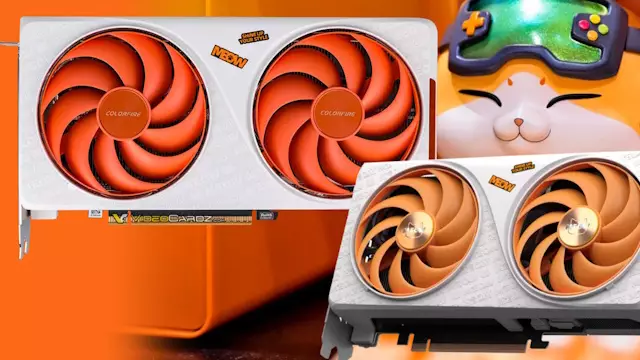In a bold stroke of design and innovation, the GPU marketplace has recently been graced by two brand-new offerings from the ever-vibrant manufacturer, Colorful. The Colorfire Meow series has made its debut, featuring the newly launched Nvidia RTX 5050 series cards, styled in a striking and somewhat overwhelming orange. This move is particularly baffling given the simultaneous introduction of another variant within their iGame Ultra lineup, featuring a model of the same RTX lineup. The essence of this decision brings us into uncharted territory, one characterized by alternate aesthetics and confusing product segmentation.
Nvidia’s announcement of the RTX 50 series came as a surprise, breaking through earlier expectation leaks and enchanting audiences with intriguing specs. Yet, deliberating over the naming conventions and lineup diversity, consumers are left wondering about the logic behind the Colorfire Meow and iGame Ultra models, especially when nestled amidst the powerhouse RTX 40 series characteristics but with the addition of DLSS 4 capabilities—Nvidia’s cutting-edge advancement in AI-supported gaming technology. These innovations may position the 5050 cards as value-driven gateways to harness the latest advancements. However, one must question whether such positioning adequately justifies their existence within the gaming ecosystem.
Design Divergence: Meow vs. iGame Ultra
A notable feature in the Colorfire Meow series is the deliberate experimental approach that Colorful seems to be adopting. This experiment contrasts starkly with the more traditional aesthetics often showcased in their iGame Ultra lineup. While the iGame Ultra cards aim for a more refined appearance—complete with a subtle blend of white chassis and vivid pink graffiti highlights—the Colorfire Meow releases dive headfirst into a decidedly quirky and playful identity. The embossed prints of “Meow” and cat motifs across its white chassis speak dramatically to an audience that values personality alongside performance, marking a daring departure from preconceptions regarding GPU design.
But herein lies the conundrum: in an industry where performance often reigns supreme, can the cuteness and uniqueness of the Colorfire Meow line sufficiently capture the interest of gamers? With only a dual-fan configuration to work with, it may cater to those looking for smaller, more budget-conscious builds. Nevertheless, while adorning orange fans create a visual spectacle, does it distract from the core performance metrics and the competitive edge that gamers seek? Many may ponder if an endearing GPU can capture the hearts of a discerning audience not often swayed by aesthetics alone.
The Performance Debate: Power or Personality?
As we dive deeper into the technical aspects of these new cards, questions about their actual power loom larger than the vibrant colors they sport. Initial hints suggest that, despite their fresh looks, these RTX 5050s might struggle to outshine cards like the RTX 4060, often seen as the benchmark for gamers seeking substantial computational strength. It’s a hard sell, especially when consumers are urged to consider the performance capacities just beneath the fun exterior.
Moreover, the speculation surrounding the performance capabilities of these cards remains heavily vested in the hopes surrounding DLSS 4 technology. For many, this potent tool has yielded effective solutions that allow even lower-end hardware to compete respectably within the gaming realm. Thus, while loyalists to Colorful might celebrate the novelty of the color-coded GPU landscape, one must ask whether the real-world performance will live up to the flashing publicity surrounding these new introductions.
Balancing Aesthetics and Functionality
Ultimately, Colorful’s foray into the GPU territory with its eye-snapping Colorfire Meow models reshapes how aesthetics can merge with functionality. The charmingly audacious color schemes and playful designs resonate with gamers who seek identity in their builds–but the heart of the matter remains: the line between eye-catching visuals and practical power is finely drawn. Only time will reveal whether enthusiasts will prioritize snazzy color cues over operational efficiency, but the Colorfire Meow cards have certainly injected a sense of excitement into an industry often heralded for its uniformity.
Perhaps this whimsical avenue taken by Colorful will pave the way for future innovations in the GPU landscape where consumer experience encompasses both performance metrics and individual expression. Let’s see how product lines develop and evolve, as the vibrant future of gaming graphics approaches us with every new launch.

